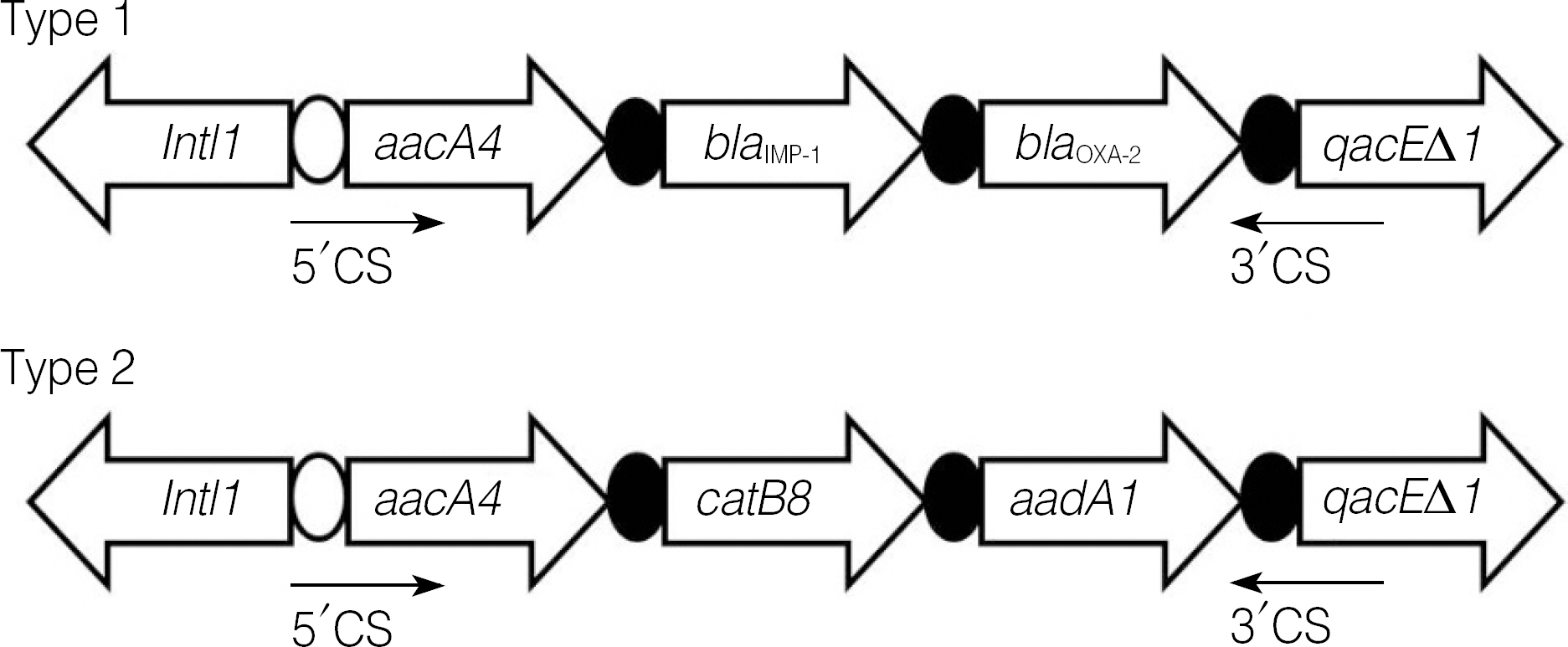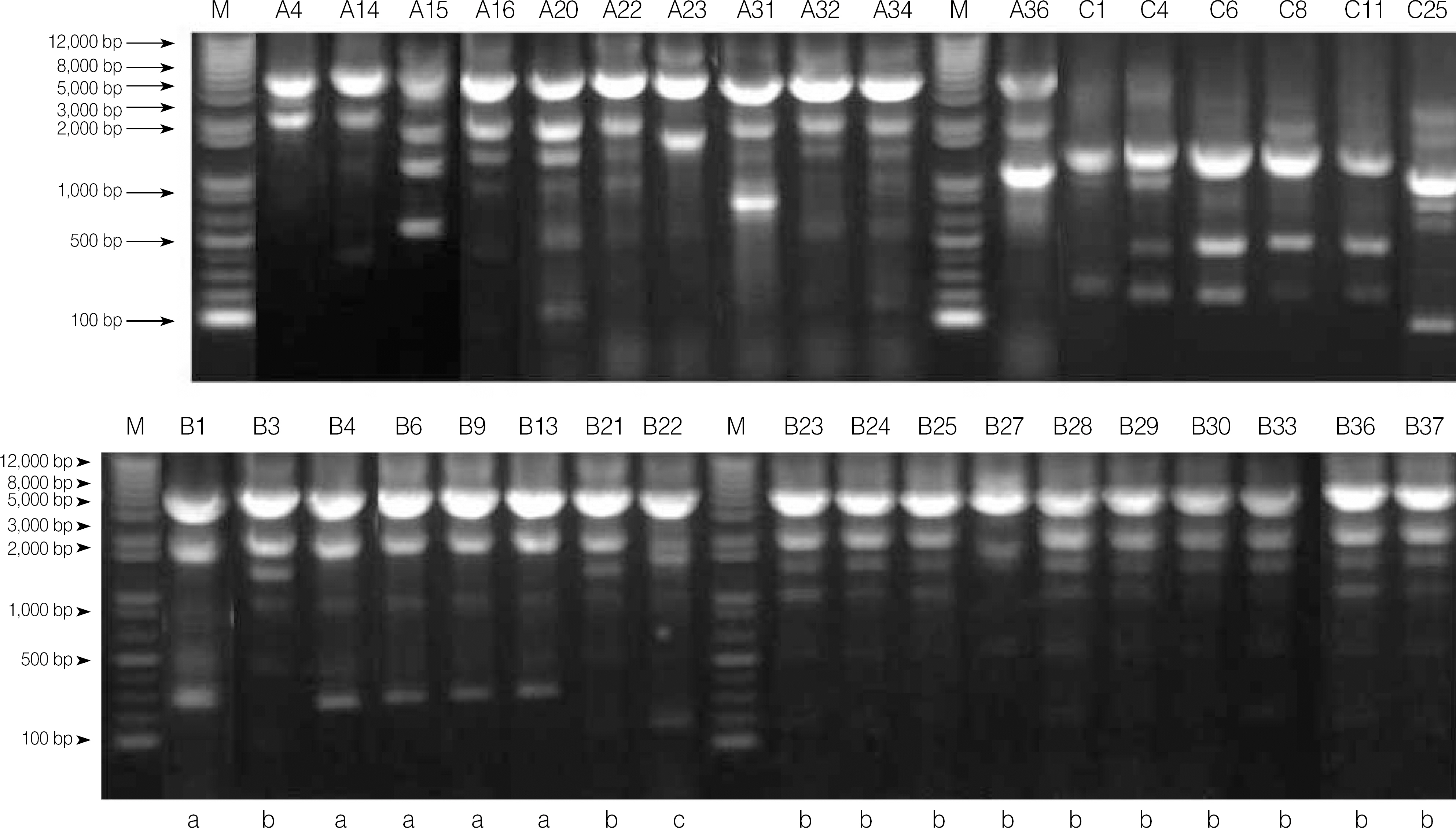Korean J Lab Med.
2010 Oct;30(5):498-506. 10.3343/kjlm.2010.30.5.498.
Genetic Basis of Multidrug-resistant Acinetobacter baumannii Clinical Isolates from Three University Hospitals in Chungcheong Province, Korea
- Affiliations
-
- 1Department of Laboratory Medicine, College of Medicine, Chungnam National University, Daejeon, Korea.
- 2Department of Biomedical Laboratory Science, Far East University, Eumseong, Korea. azaza72@naver.com
- KMID: 1022041
- DOI: http://doi.org/10.3343/kjlm.2010.30.5.498
Abstract
- BACKGROUND
The emergence of multidrug-resistant (MDR) Acinetobacter baumannii as an important opportunistic pathogen has given rise to significant therapeutic challenges in the treatment of nosocomial infections. In the present study, we assess the antibiotic resistance mechanisms of MDR A. baumannii strains by estimating the prevalence of antibiotic resistance determinants, including integrons, beta-lactamases, str genes, and gyrA and parC mutations.
METHODS
Thirty-five MDR A. baumannii clinical isolates were collected from 3 Korean university hospitals over a 2-yr period. A. baumannii was confirmed by rpoB gene analysis. For each isolate, the minimal inhibitory concentrations (MICs) of 9 antibiotics were determined by the agar dilution method. PCR and DNA sequencing were used to identify the genes that potentially contribute to each resistance phenotype.
RESULTS
Of the 35 MDR A. baumannii isolates examined, 7 antibiotic resistance gene determinants were detected. These resistance gene determinants included the gene bla(OXA-23), with an upstream element ISAba1 to promote increased gene expression and subsequent resistance to carbapenems, in 8 isolates (22.9%); aacA4, located within class 1 integrons, in 7 isolates (20.0%); and fluoroquinolone resistance conferred by gyrA and parC sense mutations in 31 isolates.
CONCLUSIONS
Of the 35 MDR A. baumannii isolates, 26 (74.3%) from both outbreak and sporadic cases possessed at least 4 of the 7 antibiotic resistance gene determinants that give rise to the MDR phenotype. The co-occurrence of several resistance determinants may present a significant threat.
MeSH Terms
-
Acinetobacter baumannii/*drug effects/*genetics/isolation & purification
Anti-Bacterial Agents/*pharmacology
Bacterial Proteins/*genetics
Carbapenems/pharmacology
Drug Resistance, Multiple, Bacterial/*genetics
Hospitals, University
Humans
Integrons/genetics
Microbial Sensitivity Tests
Republic of Korea
Sequence Analysis, DNA
Figure
Cited by 1 articles
-
Multidrug-Resistant Acinetobacter spp.: Increasingly Problematic Nosocomial Pathogens
Kyungwon Lee, Dongeun Yong, Seok Hoon Jeong, Yunsop Chong
Yonsei Med J. 2011;52(6):879-891. doi: 10.3349/ymj.2011.52.6.879.
Reference
-
1.Bergogne-Berezin E., Towner KJ. Acinetobacter spp. as nosocomial pathogens: microbiological, clinical, and epidemiological features. Clin Microbiol Rev. 1996. 9:148–65.2.Petersen A., Guardabassi L., Dalsgaard A., Olsen JE. Class I integrons containing a dhfrI trimethoprim resistance gene cassette in aquatic Acinetobacter spp. FEMS Microbiol Lett. 2000. 182:73–6.3.Recchia GD., Hall RM. Gene cassettes: a new class of mobile element. Microbiology. 1995. 141:3015–27.
Article4.Srinivasan VB., Rajamohan G., Pancholi P., Stevenson K., Tadesse D., Patchanee P, et al. Genetic relatedness and molecular characterization of multidrug resistant Acinetobacter baumannii isolated in central Ohio, USA. Ann Clin Microbiol Antimicrob. 2009. 8:21.
Article5.Sung JY., Kwon KC., Park JW., Kim YS., Kim JM., Shin KS, et al. Dissemination of IMP-1 and OXA type β-lactamase in carbapenem-resistant Acinetobacter baumannii. Korean J Lab Med. 2008. 28:16–23.6.Nemec A., Dolzani L., Brisse S., van den Broek P., Dijkshoorn L. Diversity of aminoglycoside-resistance genes and their association with class 1 integrons among strains of pan-European Acinetobacter baumannii clones. J Med Microbiol. 2004. 53:1233–40.7.Poirel L., Pitout JD., Nordmann P. Carbapenemases: molecular diversity and clinical consequences. Future Microbiol. 2007. 2:501–12.
Article8.Afzal-Shah M., Woodford N., Livermore DM. Characterization of OXA-25, OXA-26, and OXA-27, molecular class D beta-lactamases associated with carbapenem resistance in clinical isolates of Acinetobacter baumannii. Antimicrob Agents Chemother. 2001. 45:583–8.9.Naas T., Levy M., Hirschauer C., Marchandin H., Nordmann P. Outbreak of carbapenem-resistant Acinetobacter baumannii producing the carbapenemase OXA-23 in a tertiary care hospital of Papeete, French Polynesia. J Clin Microbiol. 2005. 43:4826–9.10.Mugnier PD., Poirel L., Nordmann P. Functional analysis of insertion sequence ISAba1, responsible for genomic plasticity of Acinetobacter baumannii. J Bacteriol. 2009. 191:2414–8.11.Vila J., Ruiz J., Goni P., Marcos A., Jimenez de Anta T. Mutation in the gyrA gene of quinolone-resistant clinical isolates of Acinetobacter baumannii. Antimicrob Agents Chemother. 1995. 39:1201–3.12.Lee MA., Moon HW. In vitro activity of antimicrobial combination against multidrug-resistant strains of Acinetobacter baumannii. Korean J Lab Med. 2005. 25:312–6.13.Ko KS., Suh JY., Kwon KT., Jung SI., Park KH., Kang CI, et al. High rates of resistance to colistin and polymyxin B in subgroups of Acinetobacter baumannii isolates from Korea. J Antimicrob Chemother. 2007. 60:1163–7.14.Clinical and Laboratory Standards Institute. Performance standards for antimicrobial susceptibility testing. 17th informational supplement. M100-S17. Wayne, PA: Clinical and Laboratory Standards Institute;2007.15.Mak JK., Kim MJ., Pham J., Tapsall J., White PA. Antibiotic resistance determinants in nosocomial strains of multidrug-resistant Acinetobacter baumannii. J Antimicrob Chemother. 2009. 63:47–54.16.Woodford N., Ellington MJ., Coelho JM., Turton JF., Ward ME., Brown S, et al. Multiplex PCR for genes encoding prevalent OXA carbapenemases in Acinetobacter spp. Int J Antimicrob Agents. 2006. 27:351–3.17.Vila J., Ruiz J., Goñi P., Marcos A., Jimenez de Anta T. Mutation in the gyrA gene of quinolone-resistant clinical isolates of Acinetobacter baumannii. Antimicrob Agents Chemother. 1995. 39:1201–3.18.Valentine SC., Contreras D., Tan S., Real LJ., Chu S., Xu HH. Phenotypic and molecular characterization of Acinetobacter baumannii clinical isolates from nosocomial outbreaks in Los Angeles County, California. J Clin Microbiol. 2008. 46:2499–507.19.Shin SY., Kwon KC., Park JW., Song JH., Ko YH., Sung JY, et al. Characteristics of aac(6′)-Ib-cr gene in extended-spectrum β-lactamase-producing Escherichia coli and Klebsiella pneumoniae isolated from Chungnam area. Korean J Lab Med. 2009. 29:541–50.20.Bou G., Cerveró G., Domínguez MA., Quereda C., Martínez-Beltrán J. PCR-based DNA fingerprinting (REP-PCR, AP-PCR) and pulsed-field gel electrophoresis characterization of a nosocomial outbreak caused by imipenem- and meropenem-resistant Acinetobacter baumannii. Clin Microbiol Infect. 2000. 6:635–43.21.Turton JF., Ward ME., Woodford N., Kaufmann ME., Pike R., Livermore DM, et al. The role of ISAba1 in expression of OXA carbapenemase genes in Acinetobacter baumannii. FEMS Microbiol Lett. 2006. 258:72–7.22.Gallego L., Towner KJ. Carriage of class 1 integrons and antibiotic resistance in clinical isolates of Acinetobacter baumannii from northern Spain. J Med Microbiol. 2001. 50:71–7.23.Gombac F., Riccio ML., Rossolini GM., Lagatolla C., Tonin E., Monti-Bragadin C, et al. Molecular characterization of integrons in epidemiologically unrelated clinical isolates of Acinetobacter baumannii from Italian hospitals reveals a limited diversity of gene cassette arrays. Antimicrob Agents Chemother. 2002. 46:3665–8.24.Turton JF., Kaufmann ME., Glover J., Coelho JM., Warner M., Pike R, et al. Detection and typing of integrons in epidemic strains of Acinetobacter baumannii found in the United Kingdom. J Clin Microbiol. 2005. 43:3074–82.25.Heritier C., Poirel L., Nordmann P. Cephalosporinase over-expression resulting from insertion of ISAba1 in Acinetobacter baumannii. Clin Microbiol Infect. 2006. 12:123–30.26.Corvec S., Caroff N., Espaze E., Giraudeau C., Drugeon H., Reynaud A. AmpC cephalosporinase hyperproduction in Acinetobacter baumannii clinical strains. J Antimicrob Chemother. 2003. 52:629–35.27.Akasaka T., Tanaka M., Yamaguchi A., Sato K. Type II topoisomerase mutations in fluoroquinolone-resistant clinical strains of Pseudomonas aeruginosa isolated in 1998 and 1999: role of target enzyme in mechanism of fluoroquinolone resistance. Antimicrob Agents Chemother. 2001. 45:2263–8.28.Lee JK., Lee YS., Park YK., Kim BS. Mutations in the gyrA and parC genes in ciprofloxacin-resistant clinical isolates of Acinetobacter baumannii in Korea. Microbiol Immunol. 2005. 49:647–53.
- Full Text Links
- Actions
-
Cited
- CITED
-
- Close
- Share
- Similar articles
-
- Carbapenem-Resistant Acinetobacter baumannii
- Susceptibility of Clinical Isolates of Acinetobacter baumannii and Pseudomonas aeruginosa to Colistin and Polymyxin B in Korea
- The Genetic Characteristics of Multidrug-resistant Acinetobacter baumannii Coproducing 16S rRNA Methylase armA and Carbapenemase OXA-23
- Multidrug-Resistant Acinetobacter spp.: Increasingly Problematic Nosocomial Pathogens
- Molecular Characteristics of blaOXA-23-Producing Acinetobacter baumannii Isolated from a University Hospital



